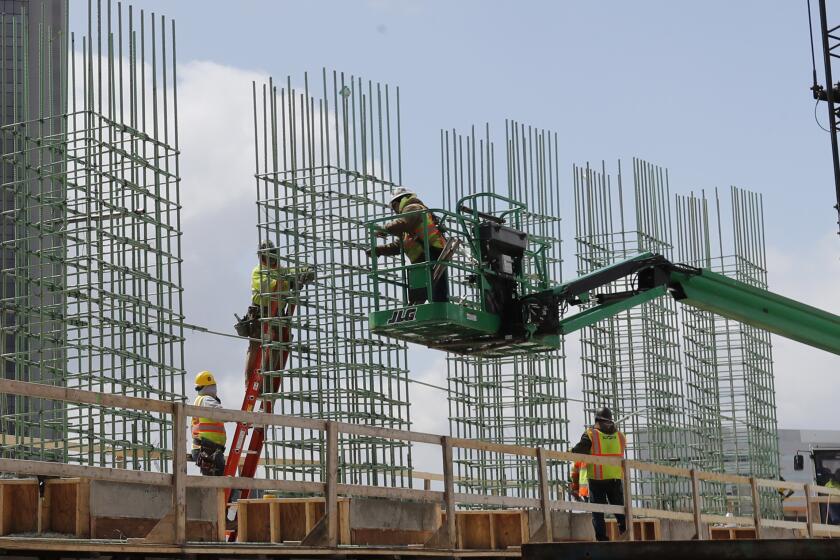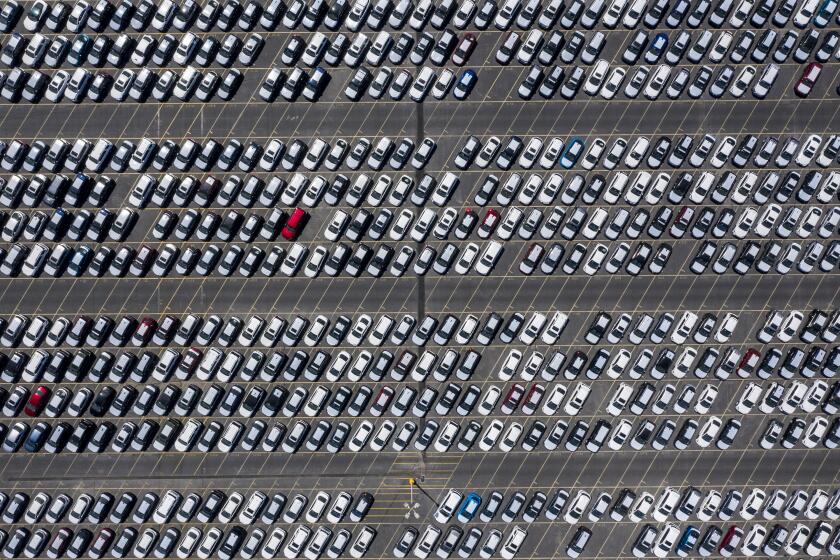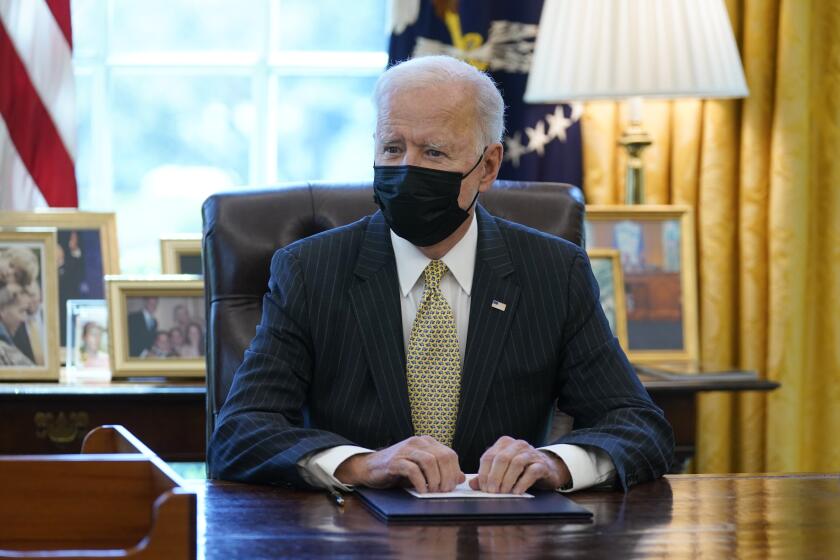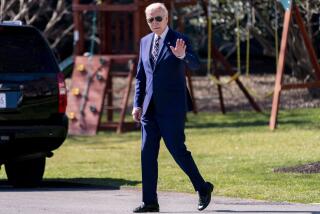Biden sees opportunity and calls for big spending on infrastructure

- Share via
WASHINGTON — President Biden launched a bold effort Wednesday to reshape American life by repairing roads, installing electric car charging stations, renovating schools, expanding broadband connectivity and much more — a vision, he said, “not seen through the eyes of Wall Street and Washington, but the eyes of hardworking people.”
The ambitious proposal, with a price tag exceeding $2 trillion over eight years, reflects Biden’s belief that the country is ready for the federal government to play a larger role in providing for its citizens, tackling climate change and modernizing its public works, recalling expansive Democratic initiatives during the New Deal and the Great Society eras.
“It’s not a plan that tinkers around the edges,” Biden said at a carpenters training center in Pittsburgh. “It’s a once-in-a-generation investment in America, unlike anything we’ve seen or done since we built the interstate highway system, and the space race, decades ago.”
Economists say Biden’s $2-trillion infrastructure package could pay for itself by boosting productivity and economic growth.
Biden is also betting that he can push the proposal through a bitterly polarized Congress where previous infrastructure initiatives have languished despite bipartisan agreement that investments are overdue and that the United States has failed to keep pace with overseas competitors like China.
Republicans have already criticized Biden’s proposals to finance the plan over 15 years with higher taxes on corporations, which would undo some of the tax cuts enacted by President Trump in 2017, while progressive Democrats are calling for even more spending than the president has outlined.
With trillions of dollars on the table, interest groups on Capitol Hill have begun maneuvering to get their favorite projects and causes included in any package, a potential feeding frenzy as large as any seen in Washington.
Sen. Sheldon Whitehouse (D-R.I.) said Biden’s proposal “is a fine starting point for Congress to begin our work” — a clear signal that Democrats will insist on putting their stamps on the package after the president got much of what he wanted in the $1.9-trillion COVID-19 relief plan that he signed three weeks ago.
A key question is whether Democrats, who hold the barest possible majority in the Senate, can push infrastructure spending through using the budget reconciliation process, a complex legislative procedure that would allow them to circumvent the possibility of a Republican filibuster and pass a bill with as few as 50 votes, with Vice President Kamala Harris serving as a tiebreaker.
Aides to Senate Majority Leader Charles E. Schumer (D-N.Y.) recently argued that the procedure can be used more than once in a fiscal year, which lawmakers have not tried before.
Biden’s infrastructure proposal includes a $174-billion investment in electric cars. But it doesn’t go as far as California’s plans.
Schumer said he was looking forward to “a big, bold plan that will drive America forward for decades to come.”
But Senate Minority Leader Mitch McConnell (R-Ky.) was dismissive, telling an audience in Kentucky on Wednesday: “It’s called infrastructure, but inside the Trojan horse is going to be borrowed money and massive tax increases on the productive parts of our economy.”
Biden has been preoccupied with the country’s recovery from the COVID pandemic and the distribution of vaccines, but he’s expected to increasingly turn his attention to passage of his infrastructure plan. He’s called the first meeting of his full Cabinet for Thursday, to discuss an administration-wide effort to promote the far-reaching blueprint.
The infrastructure announcement comes just weeks after Biden signed into law the COVID-19 relief package, which included $1,400 payments for most Americans and funding for expanded federal unemployment assistance, small businesses, schools and vaccine distribution.
“We’re meeting immediate emergencies,” he said in Pittsburgh. “Now it’s time to rebuild.”
Biden is also planning to unveil another sweeping initiative this month to expand caregiving programs for children and elderly or disabled adults, as well as family leave and healthcare benefits. If the proposals all pass, they will represent a historic investment in physical and human capital, going beyond pandemic recovery to expand benefits and potentially create millions of jobs.
The plan outlined Wednesday would advance efforts to combat climate change by pumping money into clean energy research and initiatives to swap gas vehicles for electric models. It aims to reduce racial and income inequality by targeting some spending to neighborhoods that have seen little government investment over the years. And it envisions a new era of federal government activism.
Federal debt has swelled to levels rarely seen, but shifts in politics and economic concerns mean Biden has relatively few spending constraints.
“Right now, people think you need big government,” said Celinda Lake, a Democratic pollster who worked with Biden’s campaign last year. “They’re really not sensitive to deficits. They figure the deficit will be really huge if we don’t have a recovery.”
After years in which authoritarian China has pumped money into massive public works projects, Biden and his advisors see the proposals as a way “to demonstrate the United States and democracies can deliver for the people that they serve,” said an administration official who requested anonymity to discuss Biden’s plans before the announcement.
Biden’s proposal would be financed by several changes to the tax code, most notably by raising the corporate tax rate to 28%, higher than the 21% level signed by Trump in 2017 but still lower than the 35% in place before that. The additional revenue would offset the cost of Biden’s spending over 15 years, according to his administration, and reduce the federal debt thereafter.
In his remarks, Biden twice reiterated his campaign promise to not raise taxes on any household earning less than $400,000 per year.
The infrastructure proposal is split into four main parts.
One part would provide $620 billion for transportation-related needs, such as repairing roads and expanding public transit, and for building a network of 500,000 charging stations for electric vehicles, among other improvements.
And $650 billion would be geared toward increasing broadband access, replacing lead water pipes and improving connectivity and safety. Schools, child-care facilities and veterans hospitals would be renovated.
The proposal would also invest $400 billion into caregiving programs for people who are elderly or have disabilities, and $580 billion into research and development. A chunk of the research money would be focused on clean energy, and some would be used to expand the domestic production of semiconductors, a key component in computer chips.
Times staff writers Jennifer Haberkorn and Don Lee contributed to this report.
More to Read
Get the L.A. Times Politics newsletter
Deeply reported insights into legislation, politics and policy from Sacramento, Washington and beyond. In your inbox twice per week.
You may occasionally receive promotional content from the Los Angeles Times.














